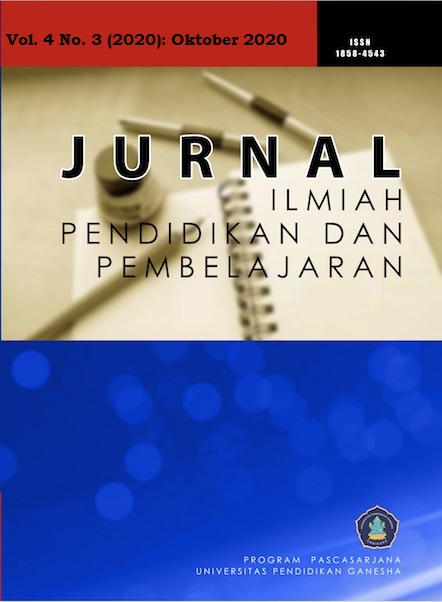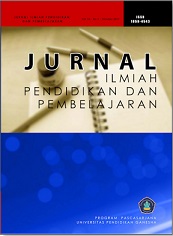The Students’ Perceptions on English Teachers’ Teaching Style and How It Affects on Learning Motivation
DOI:
https://doi.org/10.23887/jipp.v4i3.27381Keywords:
Perception, Teaching Style, Learning MotivationAbstract
This study used students’ perception to know their perception on the English teachers’ teaching style and how their perceptions affect their learning motivation in English. This study used survey method with questionnaire as the instrument that distributed to 342 students. The data was verified using interview method. The results were the students had good enough perceptions on the English teachers’ teaching style. Moreover, this result showed the students interested to learn English when the English teachers call the students by their nickname, use vocabulary that students easy to understand, give clear explanation and mastering the material, give clear instruction, demonstrate how to pronounce words, give a task to the students, ask the students to find out learning resource independently, explain material not only speech, ask the students to do discussion. Through this study, perhaps, the stakeholder makes policies to give a room such as workshops for the English teachers to know this case and encourage them in such a way, and then the English teachers can do the teaching style that makes the students interested in learning English to increase the students learning motivation.
References
Abdulbaki, K., Suhaimi, M., Alsaqqaf, A., & Jawad, W. (2018). The use of the discussion method at university: Enhancement of teaching and learning. International Journal of Higher Education, 7(6), 118–128. https://doi.org/10.5430/ijhe.v7n6p118
Alma, B. H. (2010). Guru Profesional. Alfabeta.
Amrullah, F. (2012). Buku Pintar Bahasa Tubuh Untuk Guru. DIVA Press.
Arikunto, S. (1998). Prosedur Penelitian Suatu Pendekatan Praktek. PT Rineka Cipta.
Astini, R. (2020). Kenali Penyebab susahnya Belajar Bahasa Inggris. 2014.
Bayram, Z., Oskay, Ö. Ö., Erdem, E., Özgür, S. D., & Şen, Ş. (2013). Effect of Inquiry based Learning Method on Students’ Motivation. Procedia - Social and Behavioral Sciences, 106, 988–996. https://doi.org/10.1016/j.sbspro.2013.12.112
Darsona, M. (2000). Belajar dan Pembelajaran. CV-IKIP Semarang.
Doff. (1988). Teach English: A training course for teachers. Cambridge University Press.
Gafoor, K. A. (2017). Teaching Style : A Conceptual Overview Teaching Style : A Conceptual Overview. July.
Grasha. (1996). Teaching with Style: A Practical Guide to Enhancing Learning by Understanding Teaching and Learning Styles. Alliance Publishers.
Grasha, F. (2010). The Matter as of Expert , Style : Formal and Authority , Delegator Teacher Personal Model , Facilitator ,. Teacher, 42(4), 142–149.
Hasibuan, J. J., & Moedjiono. (2010). Proses Belajar Mengajar. Bandung: Remaja Rosdakarya.
Idhaufi, N. L. M., & Ashari, Z. M. (2017). Relationship between motivation and teachers’ teaching style among secondary school students’ in Kulai. Man in India, 97(12), 299–307.
Kemendikbud. (2015). Kemendikbud RI Tahun 2015 tentang Rencana Strategis Kementrian Pendidikan Dan Kebudayaan 2015 - 2019. Kementerian Pendidikan Dan Kebudayaan, 51(2), 1–205. https://doi.org/10.1017/CBO9781107415324.004
Khan, A. (2017). Communication Skills of a Teacher and Its Role in the Development of the Students’ Academic Success. Journal of Education and Practice, 6(32), 128–140.
Kohli, R., & Solórzano, D. G. (2012). Teachers, please learn our names!: Racial microagressions and the K-12 classroom. Race Ethnicity and Education, 15(4), 441–462. https://doi.org/10.1080/13613324.2012.674026
Kurniati, I., & Surya, E. (2017). Student ’ s Perception of their Teacher Teaching Style ’ s International Journal of Sciences : Student ’ s Perception of their Teacher Teaching Style ’ s. July.
Laksmi. (2012). Interaksi, Interprestasi dan Makna. Karya Putra Darwati.
Lamatokan, A. (2018). Students’ Perception Toward Teachers’ Teaching Styles And The Use Of Learning Strategies In Teaching English. 3(2), 54–67.
Metin, M., Acisli, S., & Kolomuc, A. (2012). Attitude of Elementary Prospective Teachers Towards Science Teaching. Procedia - Social and Behavioral Sciences, 46(October 2015), 2004–2008. https://doi.org/10.1016/j.sbspro.2012.05.418
Nir, & Hamairi. (2014). ‘School Principals’ Leadership Style and School outcomes: The Mediating Effect of Powerbase Utilization’. Journal of Education Administration, 2010–2227.
Padmadewi, N. N., Artini, L. P., & Agustini, Eka, D. A. (2017). Pengantar Micro Teaching. PT RajaGrafindo Persada.
Patanduk, S. (2017). Students ’ Perception Toward Politeness and Impoliteness of the Lecturers of English Department at UKI TORAJA. 104–119.
Penny. (1996). A Course in Learning Teaching Practice and Theory. Cambridge University Press.
Rasmitadila, Samsudin, A., & Prasetyo, T. (2019). Teacher-students’ instructional interactions analysis (TSIIA): A case study in inclusive English classrooms in Indonesia. International Journal of Interdisciplinary Educational Studies, 14(1), 1–22. https://doi.org/10.18848/2327-011X/CGP/v14i01/1-22
Ratminingsih, N. M., Artini, L. P., & Padmadewi, N. N. (2017). Incorporating Self and Peer Assessment in Reflective Teaching Practices. Glasgow Mathematical Journal, 8(1), 59–62. https://doi.org/10.1017/S0017089500000094
Richmond. (1990). Communication in the class room :Power and Motivation. Communication Education.
Robinson, A. (1998). Asas-Asas Praktik Mengajar. Bhratara.
Roestiyah. (1991). Strategi Belajar Mengajar. Bina Aksara.
Roestiyah. (2001). Strategi Belajar Mengajar. Rineka Cipta.
Sardiman, A. . (2011). Interaksi & Inovasi Belajar Mengajar. Rajawali Pers.
Slameto. (2010). Belajar dan Faktor-Faktor yang Mempengaruhinya. Rineka Cipta.
Sowell, J. (2017). Good Instruction-Giving in the Second-Language Classroom. English Teaching Forum, 10–19.
Sumerti, N. M. (2018). Guru Kreatif Inspiratif dan Inovatif. Pustaka Expresi.
Suryosubroto. (1997). Proses Belajar Mengajar Di Sekolah. PT Rineka Cipta.
Usman, M. (2010). Bandung: Remaja Rosdakarya. Remaja Rosdakarya.
Vărăşteanu, C.-M., & Iftime, A. (2013). The Role of the Self-esteem, Emotional Intelligence, Performance Triad in Obtaining School Satisfaction. Procedia - Social and Behavioral Sciences, 93, 1830–1834. https://doi.org/10.1016/j.sbspro.2013.10.125
Yoshida, T. (2016). Beyond repeat After Me: Teaching Pronunciation. TESOL Press.
Downloads
Published
How to Cite
Issue
Section
License
Authors who publish with the Jurnal Ilmiah Pendidikan dan Pembelajaran (JIPP) agree to the following terms:
- Authors retain copyright and grant the journal the right of first publication with the work simultaneously licensed under a Creative Commons Attribution License (CC BY-SA 4.0) that allows others to share the work with an acknowledgment of the work's authorship and initial publication in this journal.
- Authors are able to enter into separate, additional contractual arrangements for the non-exclusive distribution of the journal's published version of the work (e.g., post it to an institutional repository or publish it in a book), with an acknowledgment of its initial publication in this journal.
- Authors are permitted and encouraged to post their work online (e.g., in institutional repositories or on their website) prior to and during the submission process, as it can lead to productive exchanges, as well as earlier and greater citation of published work. (See The Effect of Open Access)










